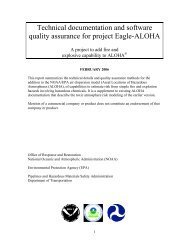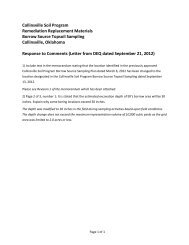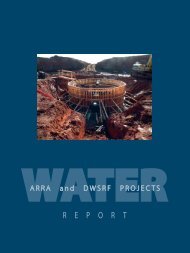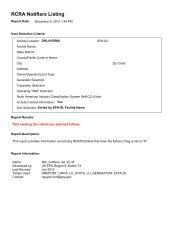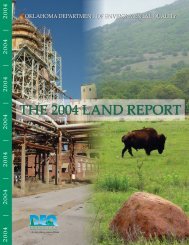Oklahoma Gas & Electric Muskogee Generating Station Best ...
Oklahoma Gas & Electric Muskogee Generating Station Best ...
Oklahoma Gas & Electric Muskogee Generating Station Best ...
You also want an ePaper? Increase the reach of your titles
YUMPU automatically turns print PDFs into web optimized ePapers that Google loves.
<strong>Oklahoma</strong> <strong>Gas</strong> & <strong>Electric</strong><br />
<strong>Muskogee</strong> <strong>Generating</strong> <strong>Station</strong> – BART Determination<br />
May 28, 2008<br />
that can result in reflective ash deposits on the waterwall surfaces. Because most heat<br />
transfer in the furnace is radiant, reflective ash can result in less heat removal from the<br />
furnace and higher exit gas temperatures. If ammonia is injected above the appropriate<br />
temperature window, it can actually lead to additional NOx formation.<br />
SNCR control systems have not been designed or installed on large subbituminous coalfired<br />
boilers, and, as described above, there are several currently unresolved technical<br />
difficulties with applying SNCR to large subbituminous coal-fired boilers (including the<br />
physical size of the boiler, inadequate NH3 mixing, and ash characteristics). Even<br />
assuming that SNCR could be installed on <strong>Muskogee</strong> Units 4 & 5, NOx control<br />
effectiveness would be marginal, and, depending on boiler exit temperatures, could actually<br />
result in additional NOx formation. Because SNCR has not been designed for, or<br />
demonstrated on, a large subbituminous coal-fired boiler, it was determined that the control<br />
technology is not applicable to <strong>Muskogee</strong> Units 4 & 5, and SNCR will not be evaluated<br />
further in the BART determination.<br />
3.2.2.2 Selective Catalytic Reduction<br />
Selective Catalytic Reduction (SCR) involves injecting ammonia into boiler flue gas in the<br />
presence of a catalyst to reduce NOx to N2 and water. Anhydrous ammonia injection<br />
systems may be used, or ammonia may be generated on-site from a urea feedstock. The<br />
overall SCR reactions are:<br />
4NH3 + 4NO + O2 → 4N2 + 6H2O<br />
8NH3 + 4NO2 + 2O2 → 6N2 + 12H2O<br />
The performance of an SCR system is influenced by several factors including flue gas<br />
temperature, SCR inlet NOx level, the catalyst surface area, volume and age of the catalyst,<br />
and the amount of ammonia slip that is acceptable.<br />
The optimal temperature range depends on the type of catalyst used, but is typically<br />
between 560 o F and 750 o F to maximize NOx reduction efficiency and minimize ammonium<br />
sulfate formation. This temperature range typically occurs between the economizer and air<br />
heater in a large utility boiler. Below this range, ammonium sulfate is formed resulting in<br />
catalyst deactivation. Above the optimum temperature, the catalyst will sinter and thus<br />
deactivate rapidly. Another factor affecting SCR performance is the condition of the<br />
catalyst material. As the catalyst degrades over time or is damaged, NOx removal<br />
decreases.<br />
15



